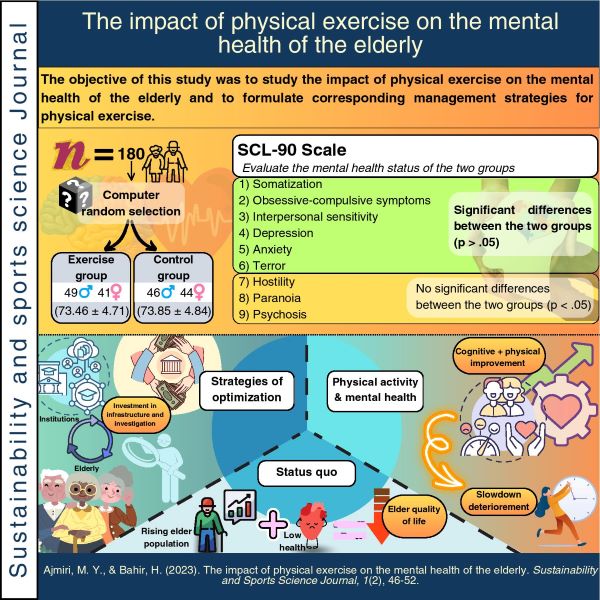The impact of physical exercise on the mental health of the elderly
Main Article Content
Abstract
Objective. To study the impact of physical exercise on the mental health of the elderly, and to formulate corresponding management strategies for physical exercise. Methods. From February 2018 to February 2019, 180 elderly people were selected from the community as research subjects. The elderly people included in the group were randomly divided into a physical exercise group and a control group, and the symptom self-rating scales of the two groups were compared. (SCL-90) score. Results. The scores of somatizations, obsessive-compulsive symptoms, interpersonal sensitivity, depression, anxiety, and terror of the elderly in the physical exercise group were significantly lower than those in the control group (p < . 05); there was no significant difference in the scores of hostilities, paranoia, and psychosis between the two groups (p > .05). Conclusion. The mental health of the elderly is an important factor affecting their quality of life, and strengthening the way and content of physical exercise for the elderly can effectively regulate the mental health of the elderly, thereby promoting the improvement of their quality of life and, to a certain extent, alleviating the social and social problems brought about by population aging. Economic pressure is of great significance to the long-term and stable development of society.
Article Details

This work is licensed under a Creative Commons Attribution-NonCommercial-ShareAlike 4.0 International License.
References
Castelli, D. M., Hillman, C. H., Buck, S. M., & Erwin, H. E. (2007). . 239-252. https://doi.org/10.1123/jsep.29.2.239 DOI: https://doi.org/10.1123/jsep.29.2.239
Desheng, L. (2019). Analysis on Different Strength Characteristics of Track and Field Athletes Based on Physical Health Consciousness. Iwedss, 1213-1217. https://doi.org/10.25236/iwedss.2019.268
Dyson, B. (2014). Quality physical education: A commentary on effective physical education teaching. Research Quarterly for Exercise and Sport, 85(2), 144-152. https://doi.org/10.1080/02701367.2014.904155 DOI: https://doi.org/10.1080/02701367.2014.904155
Edwards, N. C. (2006). School Facılıtıes And Student Achıevement: Student Perspectıves On The Connectıon Between The Urban Learnıng Envıronment And Student Motıvatıon And Performance. In Global Shadows: Africa in the Neoliberal World Order (Vol. 44, Issue 1959).
Khwajamir, M. (2016). History and Problems of Education in Afghanistan. SHS Web of Conferences, 26, 01124. https://doi.org/10.1051/shsconf/20162601124 DOI: https://doi.org/10.1051/shsconf/20162601124
Kissane, C. (2012). The way forward for girls' education in Afghanistan. Journal of International Women's Studies, 13(4), 10-28.
Newton, R. U., Murphy, A. J., Humphries, B. J., Wilson, G. J., Kraemer, W. J., & Häkkinen, K. (1997). Influence of load and stretch shortening cycle on the kinematics, kinetics and muscle activation that occurs during explosive upper-body movements. European Journal of Applied Physiology and Occupational Physiology, 75(4), 333-342. https://doi.org/10.1007/s004210050169 DOI: https://doi.org/10.1007/s004210050169
Pantović, M., Madić, D., Popović, B., Batez, M., & Obradović, J. (2015). Efekti primene vibracionog treninga i treninga sa dodatnim spoljašnjim opterećenjem na razvoj snage kod 13-godišnjeg dečaka nakon lezije m. biceps femoris i posttraumatske kalcifikacije. Vojnosanitetski Pregled, 72(7), 646-650. https://doi.org/10.2298/VSP140228040P DOI: https://doi.org/10.2298/VSP140228040P
Rittweger, J. (2010). Vibration as an exercise modality: How it may work, and what its potential might be. European Journal of Applied Physiology, 108(5), 877-904. https://doi.org/10.1007/s00421-009-1303-3 DOI: https://doi.org/10.1007/s00421-009-1303-3
Santonja Medina, F. M., Sainz De Baranda Andújar, P., Rodríguez García, P. L., López Miñarro, P. A., & Canteras Jordana, M. (2007). Effects of frequency of static stretching on straight-leg raise in elementary school children. Journal of Sports Medicine and Physical Fitness, 47(3), 304-308.
Van den Berghe, L., Vansteenkiste, M., Cardon, G., Kirk, D., & Haerens, L. (2014). Research on self-determination in physical education: Key findings and proposals for future research. Physical Education and Sport Pedagogy, 19(1), 97-121. https://doi.org/10.1080/17408989.2012.732563 DOI: https://doi.org/10.1080/17408989.2012.732563
Wei, W., Wei, J., & Fang, W. (2021). Application Analysis of Flipped Classroom Based on Wechat Public Platform in Basketball Physical Education Teaching. Journal of Physics: Conference Series, 1744(4). https://doi.org/10.1088/1742-6596/1744/4/042228 DOI: https://doi.org/10.1088/1742-6596/1744/4/042228
Wood, T. M., Maddalozzo, G. F., & Harter, R. A. (2002). Accuracy of seven equations for predicting 1-RM performance of apparently healthy, sedentary older adults. Measurement in Physical Education and Exercise Science, 6(2), 67-94. https://doi.org/10.1207/S15327841MPEE0602_1 DOI: https://doi.org/10.1207/S15327841MPEE0602_1




